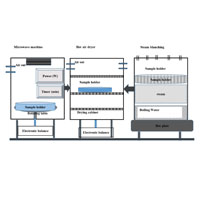Microwave and steam blanching as pre-treatments before air drying of Moringa oleifera leaves

All claims expressed in this article are solely those of the authors and do not necessarily represent those of their affiliated organizations, or those of the publisher, the editors and the reviewers. Any product that may be evaluated in this article or claim that may be made by its manufacturer is not guaranteed or endorsed by the publisher.
Authors
The objective of this work was to identify the optimal drying conditions to produce better quality dried Moringa oleifera leaves with the best drying kinetics using microwave and steam blanching pre-treatments prior to hot air drying. For this purpose, the effect of microwave power, microwave time, steaming time, and air temperature on drying kinetics and quality of Moringa leaves was evaluated using the response surface methodology. In order to achieve a moisture content of 8.0% kg H2O/kg dry matter, the optimal conditions identified were a steaming time of 2.58 min (2 min 35 sec) prior to air drying at 70°C and a microwave power of 270 W for 3 min, followed by air drying at 70°C. At this optimal condition, a confirmation test for steam-assisted air drying gave a drying time (DT) of 53 min, ascorbic acid (AA) of 2.49 mg/g, and the antioxidant activity (AOA) of 67.244% inhibition. For microwave-assisted air drying, the confirmation experiment gave a DT of 43 min, AA of 2.699 mg/g, and AOA of 74.46% inhibition. Both pre-treatments before air drying followed a falling rate drying period at the initial stages and later a constant rate drying period. Our results showed that microwave blanching should be considered as a pre-treatment in industrial production of Moringa leaves to produce better quality dried products in a relatively short time.














